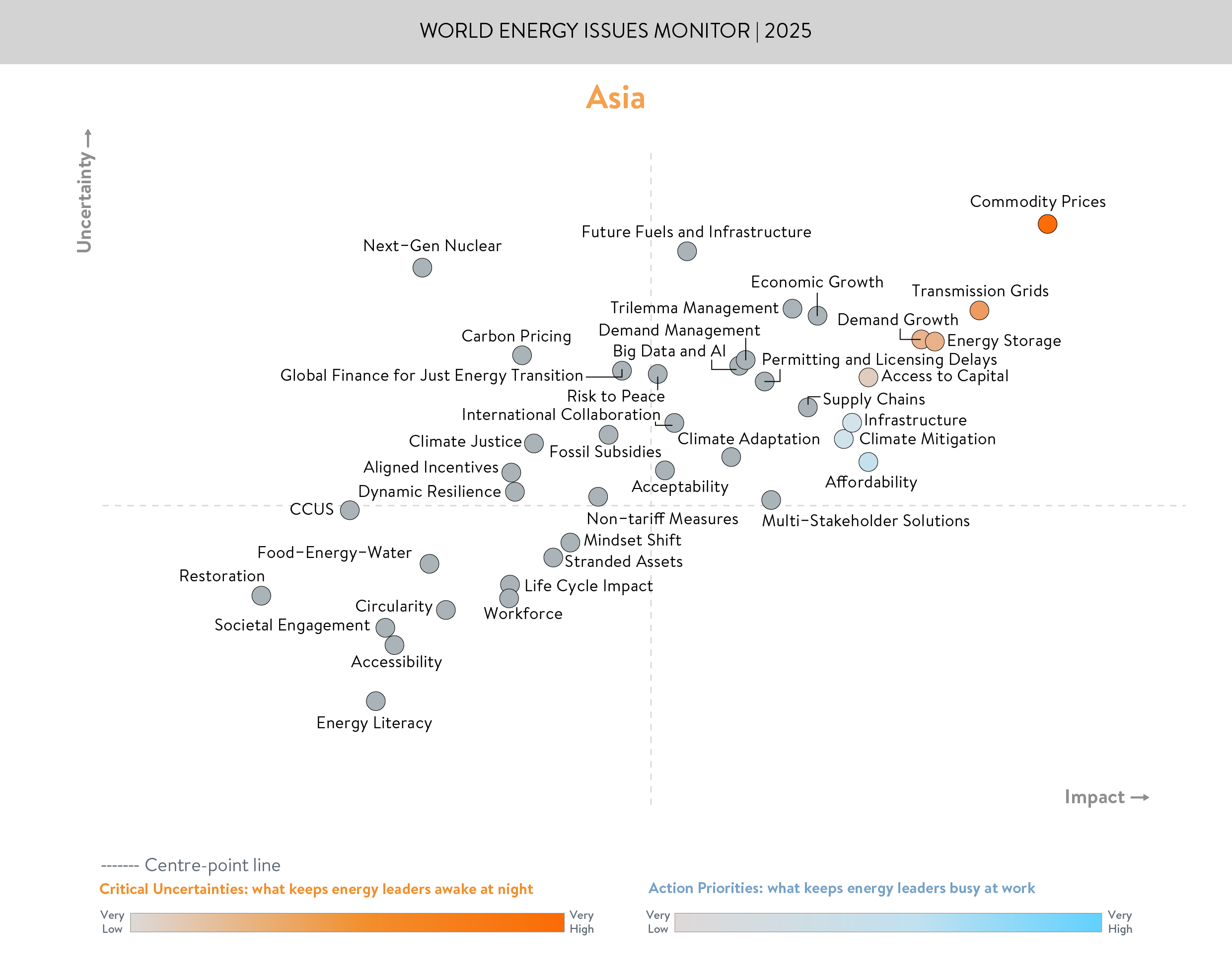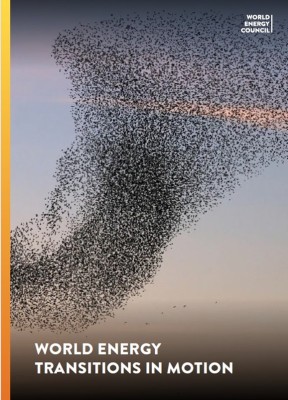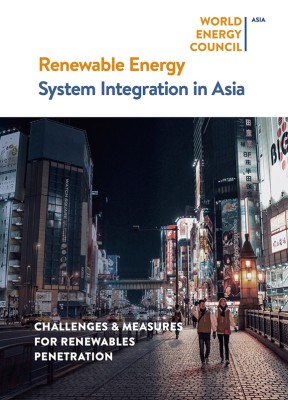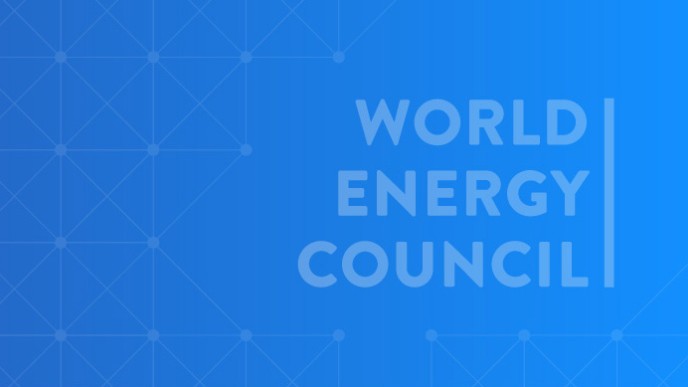ASIA NETWORK
The Asia regional network currently spans from New Zealand in the East, includes major economies such as Japan and China, and reaches India, Sri Lanka, and Pakistan in the South East. It is a large and diverse network in terms of its economic stages, culture, and language as well as energy issues it faces.
Key issues for the Asia region currently include accelerating the pace of transition to carbon neutrality, mitigating the risks associated with digitalisation and implementing new market design mechanisms. Recently, hydrogen has moved to the forefront of the discussion in many Asian countries as a potential way to decarbonise.
Regional action priorities that support the Council’s mission and humanising energy vision are agreed on an annual basis by national Member Committees in the framework of a Regional Action Plan. In 2021, Asian members joined forces to drive forward conversations on the future of hydrogen in the region.
Each month, the Asian regional network meets to discuss matters of mutual interest, drive collective activities, and keep each other updated on relevant developments and events. In addition, throughout the year regionally targeted workshops are being organised to advance discussions in the context of our global insights and innovation tools.
To drive action and achieve impact, members in the region work in partnerships with energy-related non-governmental agencies and other regional energy organisations including the Asian Development Bank (ADB), the Asian Infrastructure Investment Bank (AIIB), Asia Pacific Economic Cooperation (APEC), the Asia Pacific Energy Research Centre (APERC), the Institute of Energy Economics, Japan (IEEJ) and the Association of Southeast Asian Nations (ASEAN).
Conversations on hydrogen brought together stakeholders from the region and beyond.
A first webinar The Future for Hydrogen in the Asia Pacific was led by the Japanese Member Committee and explored the different drivers for hydrogen demand and emerging national hydrogen strategies, drawing on key findings from a recent Council survey.
A second webinar was co-hosted by the World Energy Council Hong Kong, WBCSD and ERM under the theme of The Emerging Hydrogen Economy in the Asia Pacific Region. The discussion built on the Council’s Innovation Insights Briefing Hydrogen on the Horizon: Ready, Almost Set, Go? and focused on different hydrogen strategies and action priorities in the Asia Pacific region and used.
Energy in Asia

INTRODUCTION
East and Southeast Asian energy landscape is shaped by a complex interplay of demographics, economic growth and resource endowments. As energy demand surges, countries across these regions are pursuing varied pathways to ensure security, affordability and sustainability.
China and India – the world’s two largest energy consumers – are aggressively expanding renewables while maintaining coal for reliability. China’s dual carbon strategy (carbon peak by 2030, carbon neutrality by 2060) has driven rapid renewable deployment. However, with nearly 30% of its population expected to be over 60 years by 2035, energy demand is shifting toward healthcare, home automation, and smart grids to support an ageing society. India, with over 65% of its population under 35, faces surging energy demand from industrialization, urbanization, and digital expansion. Expanding solar, wind, and green hydrogen is a priority.
Japan and South Korea are both highly import-dependent, these nations rely on nuclear restarts, LNG, and innovation in hydrogen-based fuels to enhance energy security. Japan’s ageing population – with over 40% expected to be over 65 by 2050 – will shift energy use patterns, with rising demand for residential automation, cooling, and healthcare infrastructure. South Korea AI-driven industries shaping future energy needs, emphasising efficiency, automation and resilience.
Southeast Asia presents a diverse mix. Indonesia and Vietnam remain reliant on fossil fuels, while Singapore, Thailand, and Malaysia advance regional grid integration and renewables-led growth. Indonesia’s youth bulge (40% under 25) is driving demand for manufacturing, transport, and digital economies, with electrification a key enabler of economic growth. Hydropower dominates in Laos, Cambodia, and Myanmar, enabling cross-border electricity exports.
The 2025 World Energy Issues Monitor highlights renewable deployment, grid modernisation, and AI-driven digitalisation as transformative forces across the region. Ensuring affordable and equitable access remains a stop concern, especially for rural and lower-income communities.
While regional cooperation initiatives like the ASEAN Power Grid are advancing, fragmented governance, commodity price volatility, and affordability challenges continue to pose risks.
|
ABOUT THE WORLD ENERGY ISSUES MONITOR Energy transitions are complex, evolving, and deeply interconnected, shaped by shifting priorities, emerging uncertainties, and regional realities. Since 2009, the World Energy Issues Monitor has offered a unique lens into the dynamic forces driving energy transitions worldwide. This year’s survey spans 39 core transition issues across six categories – spotlighting blind spots, new signals, and shifting leadership priorities. Amid growing uncertainty, leaders across the World Energy Council community are asking sharper questions: What’s working? What can be adapted across regions? And where are the real opportunities to turn blind spots into bright spots?
NOTE ON TIMING AND CONTEXT The world Energy Issues Monitor was conducted between 24 November 2024 and 10 January 2025. The regional workshops that informed the commentary insights took place in the second half of February 2025, before the current trade tensions and the US-led trade tariffs. As such, the regional commentaries should be read in the context in which they were developed, prior to the escalation of current global trade dynamics. |
CRITICAL UNCERTAINTIES AND ACTION PRIORITIES
Top Critical Uncertainty: Commodity Prices
Asia’s dominance in global manufacturing, its substantial reliance on imported fossil fuels and critical minerals makes it highly vulnerable to commodity price fluctuations, compounded by geopolitical risks.
- Geopolitical Tensions (e.g., South China Sea disputes) and retaliatory tariffs – threaten supply chains for oil, gas, lithium, and solar-grade silicon, increasing cost volatility.
- Rapid growth in emerging economies magnifies commodity-driven price shocks with rising coal and gas prices directly impacting consumer electricity tariffs.
- Asia leads in solar PV and battery manufacturing but remains dependent on nickel, cobalt, and rare earth imports – price spikes could undermine regional competitiveness.
Top Action Priority: Affordability
Energy pricing and costs management define the region’s strategic responses, balancing industrial competitiveness and social equity.
- Targeted subsidies and incentives e.g. Vietnam’s solar adoption experience shows how targeted incentives plus moderate end-user prices can spur fast renewables uptake.
- Competitive electricity tariffs are essential for sustaining manufacturing hubs in China, Indonesia and Malaysia, even as they pursue low-carbon pathways.
- Energy efficiency measures – South Korea industrial LED retrofitting, AI-driven energy management systems have significantly reduced operational costs.
|
Box 1: Energy-Cyber Nexus – AI and Grid Resilience in Asia
|
BLIND SPOTS AND BRIGHT SPOTS
Energy transitions are creating pockets of rapid transformation in industrial hubs, but region-wide decarbonisation remains in its early stages, often constrained by commodity price swings and uneven affordability. Some initiatives flourish, while others stall or remain underdeveloped. The 2025 data reveals:
Blind Spots
- Societal Engagement and Energy Literacy
Many individuals are unaware of their role in shaping the energy future. Without greater stakeholder engagement in initiatives like demand response or community solar, project delays and financing difficulties are likely to persist.
- Workforce and Skills Gaps
Given the scale of Asia’s energy transitions, the limited focus on workforce development is surprising. Countries like New Zealand face bottlenecks in training and retaining engineers and technical specialists. Meanwhile, India produces over 1.5 million engineering graduates annually— highlighting the potential for regional talent-sharing initiatives to bridge skill gaps.
- Accessibility
While large-scale grid projects dominate investment, microgrids and distributed energy solutions remain underexplored. These could play a crucial role in ensuring energy access for remote and underserved communities.
Bright Spots
- China: Dual-Carbon Strategy Driving Large-Scale Renewable Expansion and Cost Stability
Last year China achieved its 2030 renewable electrification target six years ahead of schedule. A regulated electricity pricing system ensures stability, while market reforms gradually expand. Alongside this rapid scale-up, China’s extensive deployment of solar PV and third-generation nuclear technologies has contributed to significant cost reductions.
- India: Biofuels Expansion
India's commitment to ethanol blending represents a transformative approach to energy security, environmental sustainability, and economic development. With a significant increase in ethanol production capacity and blending percentages, the government is making substantial strides towards its ambitious target of 20% blending by 2025
- ASEAN: Regional Grid Collaboration
The ASEAN Power Grid is gaining momentum under Malaysia’s 2025 chairmanship, marking a crucial step toward greater regional integration and cross-border electricity trade. As both an infrastructure and governance initiative, it supports energy security, affordability, and resilience across diverse energy systems.
- AI and Digitalisation in Energy Management
AI is increasingly used for grid optimisation, demand forecasting, and smart energy management, enhancing energy security and efficiency. China’s digital twin of its power grid is a standout example, enabling real-time simulation and smarter system planning at scale.
|
Box 2: Key Implications for Humanising Energy – Asia
|
CONCLUSION
Much like observing a flock in motion, Asia’s energy transition reveals distinct patterns—some swirling with uncertainty, others aligning toward clearer momentum. These patterns confirm:
- Commodity Prices rank as the biggest Critical Uncertainty, reflecting Asia’s reliance on imported fossil fuels and vulnerability to global price swings. This ongoing risk underscores volatility in both economic growth and energy markets.
- Affordability emerges as the top Action Priority – central to balancing industrial competitiveness and social equity, especially as energy demand rises across emerging markets. Leaders are responding through innovative tariffs, targeted subsidies, and energy efficiency measures.
- Blind spots include societal engagement and workforce gaps. Strengthening energy literacy, expanding skills training, and engaging communities in infrastructure development will be essential to sustaining momentum.
- Bright spots – such as China’s renewable cost reductions, India’s clean energy initiatives, ASEAN’s cross-border grid integration – highlight the power of local leadership and regional collaboration in driving progress.
Recognising these patterns reveals that Asia’s energy transition does not follow a single blueprint but emerges from the collective capacity to adapt to shifting regional and global realities. The interaction between challenges and innovative breakthroughs illustrates the multifaceted nature of the region’s journey toward a more secure, affordable, and sustainable energy future.
KEY CONTRIBUTORS:
In addition to thanking experts from across our community for their contributions, we would like to make special mention of Kim Yin Wong, Group President & CEO at Sembcorp Industries and Asia Chair at the World Energy Council; Dr. Jiang Kejun, Senior Researcher at the Energy Research Institute, China; Tina Schirr, Executive Director at the Business Energy Council New Zealand; and Ramit Kalia, Manager at Engineers India Ltd. and Member of the Future Energy Leaders Board Member at the World Energy Council.
Downloads

World Energy Issues Monitor 2025
Download PDF
World Energy Issues Monitor 2025 - Asia Regional Commentary
Download PDF
World Energy Issues Monitor 2025 - Asia Regional Commentary (Chinese Translation)
Download PDFDownloads

Renewable Energy Systems Integration in Asia - Full Report
Download the Report
Renewable Energy Systems Integration in Asia - Executive Summary
Download the Executive Summary






